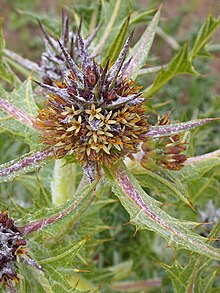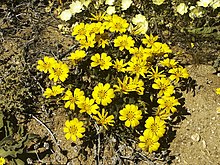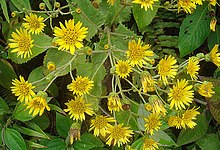Cichorioideae
| Cichorioideae | ||||||||||||
|---|---|---|---|---|---|---|---|---|---|---|---|---|

Forest hawkweed ( Hieracium murorum ) |
||||||||||||
| Systematics | ||||||||||||
|
||||||||||||
| Scientific name | ||||||||||||
| Cichorioideae | ||||||||||||
| ( Yuss. ) Chevall. |
The Cichorioideae are a subfamily in the Asteraceae plant family. The genera of this subfamily were formerly known as ray blooms or ray blooms . Today only the name Cichorioideae is used. The approximately 224 genera with approximately 3600 species are distributed almost worldwide.
description
There are mainly herbaceous plants in this subfamily, but woody plants are also found. Parts of the plant in this subfamily mostly show milky sap .
In the cup-shaped inflorescence , the representatives that occur in Central Europe only contain ray-flowers . In the tribe Arctotideae , however, ray florets and tubular florets occur . The tongue of the corolla has five corolla lobes, which clearly shows that the corolla is made up of five petals . But there is also a clear difference to the Asteroideae , whose tongues have three corolla lobes. The two branches of the style end pointy.
There are achenes formed.

Systematics
The subfamily Cichorioideae (Juss.) Chevall. was established in 1828. Synonyms for Cichorioideae (Juss.) Chevall. are: Aposeridaceae Raf. , Arctotidaceae Berchtold & J.Presl , Cichoriaceae Juss. nom. cons., Lactucaceae Drude , Picridaceae Martynov , Vernoniaceae Burmeister .
The subfamily Cichorioideae is divided into six tribe and contains about 224 genera with about 3600 species:
- Tribe Arctotideae Cass. : It is divided into two (or three) subtribes with about 13 to 17 genera and about 200 to 220 species. In contrast to the other taxa of the subfamily, the flower heads contain ray and tubular flowers:
- Tribe Cichorieae Lamarck & DC. (Syn .: Lactuceae Cass. ): It contains about 100 genera and about 1600 species.

- Tribe Gundelieae DC. ex Lecoq & Juillet : It contains only one genus:
-
Gundelia L .: It contains one to three species, including:
- Gundelia tournefortii L .: It occurs in Turkey, Lebanon, Syria, Palestine, Israel, Jordan, Iraq, Iran, Azerbaijan and Armenia.
-
Gundelia L .: It contains one to three species, including:

- Tribe Liabeae H.Rob. & Brettell : This neotropical tribe is divided into four sub- tribes and contains about 18 genera with about 175 species since 2012. They are widespread in the Neotropics, with a focus on the Andes:
- Subtribus Liabinae: It contains about seven genera:
- Cacosmia Kunth : The three
- Subtribus Liabinae: It contains about seven genera:
- Dillandia V.A. Funk & H.Rob. : The roughly three species thrive in the Andes in Colombia, Ecuador, Bolivia and Peru (11 ° N-18.5 ° S).
- Ferreyranthus H.Rob. & Brettell : The eight or so species occur in Peru and southern Ecuador (1 ° S-15 ° S).
- Liabum Adans. : The approximately 37 species are widespread from Mexico through Guatemala, El Salvador, Honduras, Nicaragua Costa Rica, as well as Panama and the Caribbean islands to Venezuela, Colombia, Ecuador, Bolivia, Brazil, Peru and Argentina (21.5 ° N – 23 ° S) .
- Oligactis (Kunth) Cass. : The sevenor sospecies are distributed from Costa Rica via Panama to Colombia , Ecuador and Venezuela (10 ° N-4 ° S).
- Sampera V.A.Funk & H.Rob : With eight species thrive in the Andes from Colombia to northern Peru, with a center of biodiversity in Ecuador (4 ° N-6 ° S).
- Chrysactinium Kunth : The eight or so species thrive in the Andes in Ecuador and Peru (0.5 ° N-11 ° S).
- Munnozia Ruiz & Pavón s. l. (Syn. :): The 46 or so species thrive mainly in the Andes. They are distributed from Costa Rica to Panama to Venezuela, Colombia, Ecuador, Peru, Bolivia and Argentina (11 ° N-23.5 ° S).
-
Chionopappus Benth. : It contains only one type:
- Chionopappus benthamii S.F.Blake : It occurs in Peru (7 ° S-13 ° S).
- Erato DC. : The five or so species are distributed from Costa Rica via Panama to Venezuela, Colombia, Ecuador and Peru (19 ° S-33 ° S).
- Microliabum Cabrera (Syn .: Angelianthus H.Rob. & Brettell , Austroliabum H.Rob. & Brettell ): The approximately species are distributed from Bolivia to Argentina.
- Paranephelius Poepp. : The seven or so species are distributed in Bolivia, Peru and Argentina (3 ° S – 22.5 ° S).
- Philoglossa DC. : The five or so species are distributed from Colombia through Ecuador and Bolivia to Peru (0.5 ° N – 17 ° S).
- Pseudonoseris H.Rob. & Brettell : The only three species occur in Peru (3 ° S-17 ° N).
-
Stephanbeckia H.Rob. & VAFunk : It only contains one type:
- Stephanbeckia plumosa H.Rob. & VAFunk : It is only known from the type location: Bolivia , Tarija: Province of José Maria Aviléz , subiendo de Tojo a Yunchara, (21 ° 49 ′ S, 65 ° 17 ′ W), at an altitude of 2750 meters.
- Sinclairia Hook. & Arn. (Syn .: Liabellum Rydb. ,): The approximately 25 species are distributed from Mexico via Guatemala, El Salvador, Honduras, Nicaragua, Costa Rica and Panama to Colombia (23 ° N-4 ° N).
- Sinclairiopsis Rydb. : With only two species occur in Mexico (17 ° -18 ° N).
-
Bishopanthus H.Rob. : It contains only one type:
- Bishopanthus soliceps H.Rob. : It is only known from the collection of types in Peru (3 ° S-7 ° S).
- Tribus Platycarpheae V.A. Funk & H.Rob : It contains only two genera with only three species in Namibia and South Africa . The two species of the genus Platycarphella have been separated from the genus Platycarpha . They are perennial herbaceous plants with basal leaf rosettes:
-
Platycarpha Less .: It contains only one species:
- Platycarpha glomerata (Thunb.) Less. : It thrives in southeastern and eastern South Africa.
-
Platycarphella V.A. Funk & H.Rob. : It contains only two types:
- Platycarphella carlinoides (Oliv. & Hiern) VAFunk & H.Rob. (Syn .: Platycarpha carlinoides Oliv. & Hiern ): It occurs in Namibia and South Africa.
- Platycarphella parvifolia (S.Moore) VAFunk & H.Rob. (Syn .: Platycarpha parvifolia S.Moore ): It occurs in South Africa.
-
Platycarpha Less .: It contains only one species:
- Tribus Vernonieae Cass. : It contains around 117 genera that are distributed almost worldwide and predominantly thrive in tropical to warm areas.
swell
- The Asteraceae family with their subfamilies on the AP website. (Section systematics and description)
- The structure of the family with different authors.
- Vicki A. Funk, Alfonso Susanna, Tod F. Stuessy & Randall J. Bayer: Systematics, Evolution and Biogeography of the Compositae , 2009. IAPT (International Association for Plant Taxonomy). ISBN 978-3-9501754-3-1
Individual evidence
- ↑ Cichorioideae in the Germplasm Resources Information Network (GRIN), USDA , ARS , National Genetic Resources Program. National Germplasm Resources Laboratory, Beltsville, Maryland.
- ↑ Theodore M. Barkley, Luc Brouillet, John L. Strother: Asteraceae, tribe Cichorieae. In: Flora of North America Editorial Committee (Ed.): Flora of North America North of Mexico . Volume 19: Magnoliophyta: Asteridae, part 6: Asteraceae, part 1 (Mutisieae – Anthemideae). Oxford University Press, New York / Oxford a. a. 2006, ISBN 0-19-530563-9 , pp. 214-256 (English). , same text online as the printed work .
- ↑ a b Ralf Hand, Norbert Kilian & Eckhard von Raab-Straube: ICN - International Cichorieae Network , 2009.
- ↑ Gundelieae at the Tree of Life project, 2009.
- ^ Werner Greuter : Compositae (pro parte majore): Gundelia . In: Werner Greuter, Eckhard von Raab-Straube (ed.): Compositae. Euro + Med Plantbase - the information resource for Euro-Mediterranean plant diversity. Berlin 2006–2009.
- ↑ Harold Robinson: A Generic Review of the Tribe Liabeae (Asteraceae) , In: Smithsonian Contributions to Botany , Number 54, 1983.
- ↑ Harold Robinson: A redelimitation of Microliabum Cabrera (Asteraceae: Liabeae) , In: Systematic Botany , Volume 15, 1990, pp. 736-744.
- ↑ Vicki A. Funk, Harold Robinson & MO Dillon: The Liabeae: Taxonomy, Phylogeny, and Biogeography , 1996, pp. 545–567, In: DJN Hind, HJ Beentje & PDS Caligari: Proceedings of the International Compositae Conference, Kew, 1994, Vol. 1. Compositae : In: Systematics , Kew Publishing.
- ↑ a b Harold Robinson & Vicki A. Funk: Stephanbeckia plumosa (Liabeae: Compositae): A new genus and species from southern Bolivia , In: Brittonia , Volume 63, Number 1, 2011 pp. 75-82, doi : 10.1007 / s12228 -010-9136-2
- ↑ a b c d e f g h i j k l m n o p q r s t u Vicki A. Funk, Carol Kelloff & Raymund Chan: Phylogeny and biogeography of the tribe Liabeae (Compositae subfamily Cichorioideae) , In: Taxon , Volume 61, Issue 2, April 2012, pp. 437-455. Full text PDF.
- ↑ Vicki A. Funk & Harold Robinson: A bully new genus from the Andes (Compositae: Liabeae) , In: Systematic Botany , Volume 26, 2001, pp. 216-225.
- ↑ Vicki A. Funk & Harold Robinson: Sampera, a new genus of Liabeae (Compositae or Asteraceae) from the northern Andes , In: Proceedings of the Biological Society of Washington , Volume 122, Issue 2, 2009, pp. 155-161. doi : 10.2988 / 08-31.1
- ^ BL Turner: Revisionary treatment of the genus Sinclairia, including Liabellum , In: Phytologia , Volume 67, 1989, pp. 186-206.
- ↑ Vicki A. Funk, & Harold Robinson: A new tribe Platycarpheae and a new genus Platycarphella in the Cichorioideae (Compositae or Asteraceae) , pp. 24-27, In: Compositae Newsletter , Number 47, April 15, 2009. ISSN 0284- 8422 : full text PDF. ( Memento of the original from March 3, 2016 in the Internet Archive ) Info: The archive link was inserted automatically and has not yet been checked. Please check the original and archive link according to the instructions and then remove this notice.


